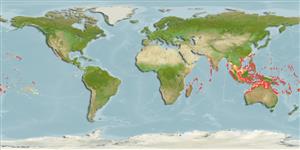Common names from other countries
>
Aulopiformes (Grinners) >
Synodontidae (Lizardfishes) > Synodontinae
Etymology: Synodus: Greek, syn, symphysis = grown together + Greek, odous = teeth (Ref. 45335).
More on author: Schultz.
Environment: milieu / climate zone / depth range / distribution range
Ecologia
marinhas associadas(os) a recifes; intervalo de profundidade 1 - 88 m (Ref. 86942), usually 1 - 10 m (Ref. 11228). Tropical; 26°N - 24°S
Indo-Pacific: Gulf of Aden and East Africa to the Hawaiian and Gambier islands, north to the Ogasawara Islands, south to the Great Barrier Reef.
Tamanho / Peso / Idade
Maturity: Lm ? range ? - ? cm
Max length : 18.0 cm TL macho/indeterminado; (Ref. 11228); common length : 10.0 cm TL macho/indeterminado; (Ref. 3520)
Espinhos dorsais (total) : 0; Raios dorsais moles (total) : 12 - 14; Espinhos anais: 0; Raios anais moles: 8 - 10. Cheek behind mouth scaled; palatine teeth in a single band on each side (characteristic of the genus); membranous flap on anterior nostrils long and broad; dorsal tip of snout with a pair of small but prominent black spots (Ref. 2334).
Occurs in coral reefs (Ref. 11228). Benthic (Ref. 58302). Generally solitary and typically rests on hard surfaces, occasionally with a head down position on a steep slope (Ref. 1602). Feeds on small fishes and shrimps (Ref. 89972). Sold fresh in markets.
Life cycle and mating behavior
Maturities | Reprodução | Spawnings | Egg(s) | Fecundities | Larvas
Cressey, R.F. and R.S. Waples, 1984. Synodontidae. In W. Fischer and G. Bianchi (eds.) FAO species identification sheets for fishery purposes. Western Indian Ocean (Fishing Area 51). Volume 4. FAO, Rome. (Ref. 3520)
Categoria na Lista Vermelha da IUCN (Ref. 130435)
CITES (Ref. 128078)
Not Evaluated
Ameaça para o homem
Harmless
Utilização humana
Pescarias: pouco comercial
Ferramentas
Relatórios especiais
Descarregue XML
Fontes da internet
Estimates based on models
Preferred temperature (Ref.
115969): 25.3 - 29.3, mean 28.4 (based on 3181 cells).
Phylogenetic diversity index (Ref.
82804): PD
50 = 0.5000 [Uniqueness, from 0.5 = low to 2.0 = high].
Bayesian length-weight: a=0.00447 (0.00211 - 0.00945), b=3.16 (2.99 - 3.33), in cm Total Length, based on LWR estimates for this Genus-body shape (Ref.
93245).
Nível Trófico (Ref.
69278): 4.0 ±0.7 se; based on size and trophs of closest relatives
Resiliência (Ref.
120179): Elevada, tempo mínimo de duplicação da população menor que 15 meses (Preliminary K or Fecundity.).
Fishing Vulnerability (Ref.
59153): Low vulnerability (10 of 100).
